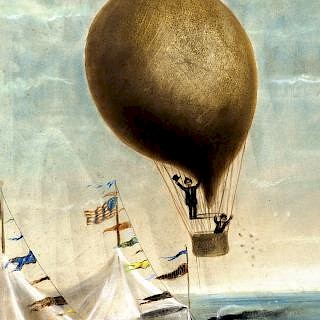Jumbo the Elephant & his Keeper, Matthew Scott, Autobiography Plus Artotypes
About Seller
6270 Este Ave.
Cincinnati , OH 45232
United States
With offices in Cincinnati, Cleveland and Denver, Cowan’s holds over 40 auctions each year, with annual sales exceeding $16M. We reach buyers around the globe, and take pride in our reputation for integrity, customer service and great results. A full-service house, Cowan’s Auctions specializes in Am...Read more
Two ways to bid:
- Leave a max absentee bid and the platform will bid on your behalf up to your maximum bid during the live auction.
- Bid live during the auction and your bids will be submitted real-time to the auctioneer.
Bid Increments
| Price | Bid Increment |
|---|---|
| $0 | $25 |
| $500 | $50 |
| $1,000 | $100 |
| $2,000 | $250 |
| $5,000 | $500 |
| $10,000 | $1,000 |
| $20,000 | $2,500 |
| $50,000 | $5,000 |
| $100,000 | $10,000 |
About Auction
Jun 13, 2014 - Jun 14, 2014
Cowan's Auctions dawnie@cowans.com
- Lot Description
Lot of 3, including: Scott, Matthew. Autobiography of Matthew Scott, Jumbo's Keeper, Formerly of the Zoological Society's Gardens, London, and Receiver of Sir Edwin Landseer Medal in 1866, Also, Jumbo's Autobiography, by the Same Author. New York: Trow's Printing and Bookbinding Co., 1885. 12mo, blue embossed cloth, 96pp.Plus 2 cabinet card-sized artotypes showing Jumbo with his keeper, Matthew Scott, and others standing by, looking at the enormous pachyderm in awe. Each image on mount with the following imprint: Jumbo/ The largest Elephant ever seen by mortal man, wild or in captivity/ The property of Messrs. Barnum, Bailey & Hutchinson. cost $30,000, and E. Bierstadt, New York backmark.Born in the French Sudan, Jumbo (1861-1885), a male African Bush Elephant, was part of a group of captured animals imported to France and kept in the Paris Zoo, Jardin des Plantes, until 1865 when he was transferred to the London Zoo. While in London, he became a popular attraction, especially for the children, who were permitted to ride him. In November 1881, for the price of $10,000, Jumbo was sold to the Barnum & Bailey Circus. P.T. Barnum transported the elephant to New York, where he was exhibited at Madison Square Garden and was later included in a group of 21 circus elephants that crossed the Brooklyn Bridge to prove that the structure was safe within a year after a stampede on the bridge resulted in the death of a dozen people.
On September 15, 1885, while in St. Thomas, Ontario, Jumbo was hit and fatally wounded by a locomotive at a railway classification yard. Following his tragic death, Barnum had portions of the elephant separated and displayed at multiple sites to attract spectators. Following this tour, Jumbo's skeleton was donated to the American Museum of Natural History in New York, his heart was sold to Cornell University, and his hide was stuffed, mounted, and traveled with Barnum's circus for two years before it was donated to Tuft's University and displayed at P.T. Barnum Hall for many years. The hide was later destroyed in an April 1975 fire, but Jumbo's legacy lives on to this day as the mascot for Tuft's University.Autobiography with some surface wear, few stains, some wear along the corners and edges, including some fraying, few interior pages with short rips, with light pink colored pencil sketch on interior of back cover. Wear to cabinet card mounts, including separation of top left corner of mount from rest of mount/image showing Jumbo being fed; corners of each mount rounded.Condition
- Shipping Info
-
SHIPPING. At the request of the buyer, Cowan's will authorize the shipment of purchased items. Shipments usually occur within two weeks after payment has been received. Shipment is generally made via UPS Ground service. Unless buyer gives special instructions, the shipping method shall be at the sole discretion of Cowan's Auctions, Inc.. Cowan's is in no way responsible for the acts or omissions of independent handlers, packers or shippers of purchased items or for any loss, damage or delay from the packing or shipping of any property.
-
- Buyer's Premium



 EUR
EUR CAD
CAD AUD
AUD GBP
GBP MXN
MXN HKD
HKD CNY
CNY MYR
MYR SEK
SEK SGD
SGD CHF
CHF THB
THB





